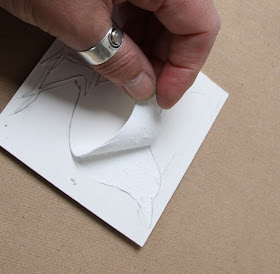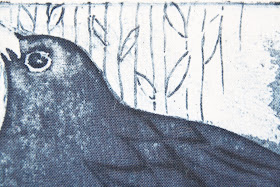How to make a basic collagraph plate from materials you may have at home.
You will need a piece of mount board or grey board (the back of an old sketch book) or 2 pieces of cereal box card stuck together, just to make it thicker if you haven't got any of the other card.
PLEASE DO NOT USE FOAM BOARD: this is board with thin white paper sandwiching a layer of polystyrene.
Start with a 10 x 10cm square.
A selection of textured wall papers (samples can be gleaned from you local DIY store)
PVA glue, for the best results use waterproof, but children's will do.
A sharp craft knife.
A 10 x10cm square is a satisfying and less daunting size to experiment with.
Of course your image can be figurative or abstract. Here I am starting with a bird from my sketch book. Trace the image using a soft B or 2B pencil.
Lay the tracing, pencil side down onto your chosen card. With a harder pencil or biro draw over the lines.
This will transfer your image onto the card and reverse it at the same time so that it prints the same way as your original. Please note, if you want to include text, reverse it so that it will print the right way round.
I have put my image onto mount board so that I can peel the surface away to create dark areas.
This process only works if you are using mount or grey board. I want my bird to be dark, so I am scoring quite deeply into the surface of the card around my bird.
This means I can peel off the shape.
The bird will print darker than the surrounding unpeeled card.
This will not work with cereal box card.
After peeling away the surface, I then draw in the details of the bird,
carving out further lines will give me darker details.
They will not print if you do not cut into the card.
Anything I want to be white I paint with the PVA glue, ie the back ground, the eye and beak of the bird have been glued too. While the glue is wet draw into it with a cocktail stick, this will give you dark lines in a white background.
Fancy doing something more abstract?
Why not glue wall paper onto the surface of the card.
Make sure the wall paper is glued right up to the edge so that there are no pockets for ink to get into when printing. WARNING: do not stick wall paper on top of wall paper, it creates pockets that bleed ink when printing.
The grey board can be worked as for the mount card, cutting and peeling the surface. Of course you can stick wall paper onto the mount board!
If you only have cereal card available stick 2 pieces together. You can not peel the surface in the same way as mount and grey board, but you could cut shapes out before gluing the 2 pieces together
and add thin cut card shapes to the plate.
Always give any wall paper you use a layer or 2 of PVA glue, it makes the texture print in a more interesting way.
Not helpful Iris!
Drawing into wet glue prints really well.
Here are the 3 different types of plate ready to ink up and print.
All the plates are now printed onto thin cotton fabric using Hawthorn Stay Open Etching ink.
The printed side of Cereal Box card wipes clean the reverse side holds a small amount of ink. Close patterned wall papers with a layer of glue print beautifully. At the top of the plate you can see the glue that has been drawn into while wet, holds a very nice line.
Grey board printed onto thin cotton.
The body of the plate holds more ink than the reverse of cereal box, this makes the glue give more contrast as a white mark and the peeled line looks very dark.
Again printed onto white cotton, this is the mount board plate.
The surface of the mount board holds ink, the glued background, drawn into has been very successful as have the glued details on the bird. The peeled area has a very dark strong contrast to the rest of the plate and the cut lines into the body show up nicely in the fabric.
Now to stitch into the prints when they are dry, I feel a patchwork quilt coming on??





























Hey Sue, this is wonderful! How are you making prints of these without a press?
ReplyDeleteThank you for all these amazing prompts
The bad news is I am not. I always use a press for collagraph.
ReplyDeleteI love this idea Sue! I have a gelatin plate that I use for making prints, usually to tear into collage material. I'd love to try making a bird collagraph though.
ReplyDeleteI was supposed to be taking a class with you in June with my daughter Bethany, hopefully one day we can book again.
Best wishes,
Alison
Loved this! I have been all over your blog after diving into prints galore. I am a member of the facebook group Craft Press Printmakers https://www.facebook.com/groups/1544918272204523 and love how it now is possible to print all sorts of stuff at home. Only limited by the width of space of rollers and had a long piece of MDF cut to size for looong prints. You are SO helpful and generous! Thank you SO much!
ReplyDeleteMuch love from Norway
Hi Sue, I love your work and i also work on Collographs. I love it because it is very easy and basic to do. What ink do you normaly use to print? Best wishes xx
ReplyDeleteHi Nila,
ReplyDeleteI use oil based etching ink.
There are so several blogs I read precisely know but any one of the content me but this one is so useful blog … custom cereal boxes
ReplyDeleteMerci beaucoup pour le partage de vos connaissances.
ReplyDeleteJ'aime beaucoup votre travail.
Thank you so much for sharing your techniques, your work is very inspiring.
ReplyDeletePete.
I read this blog. Everything mentioned in this blog is very informative. This is the best blog that I have ever seen. Keep up the good work ... custom cereal boxes
ReplyDeleteThanks for posting your methods. I'm new to colloagraph. How would you go about adding smaller text to a collagraph? I might try to write in glue and see how that prints.
ReplyDelete